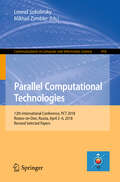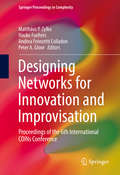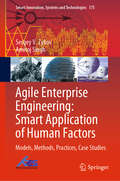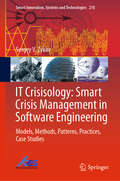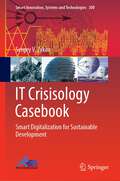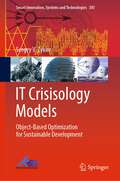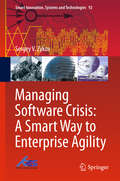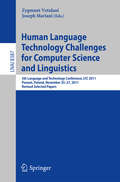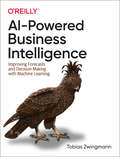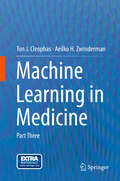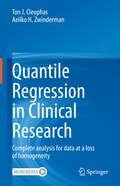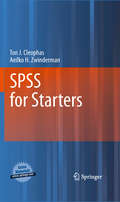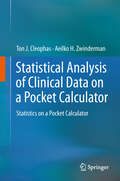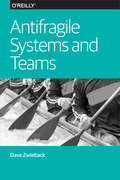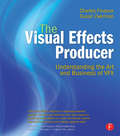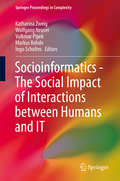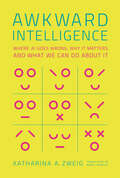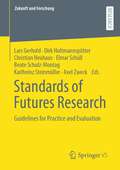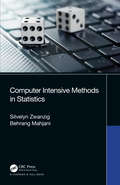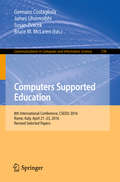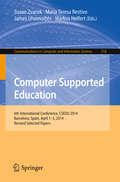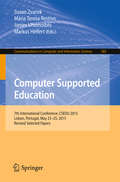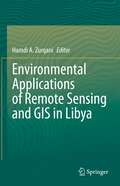- Table View
- List View
Parallel Computational Technologies: 11th International Conference, Pct 2017, Kazan, Russia, April 3-7, 2017, Revised Selected Papers (Communications In Computer And Information Science #753)
by Mikhail Zymbler Leonid SokolinskyThis book constitutes the refereed proceedings of the 12th International Conference on Parallel Computational Technologies, PCT 2018, held in Rostov-on-Don, Russia, in April 2018.The 24 revised full papers presented were carefully reviewed and selected from 167 submissions. The papers are organized in topical sections on high performance architectures, tools and technologies; parallel numerical algorithms; supercomputer simulation.
Designing Networks for Innovation and Improvisation
by Matthäus P. Zylka Hauke Fuehres Andrea Fronzetti Colladon Peter A. GloorThis volume is focused on the emerging concept of Collaborative Innovation Networks (COINs). COINs are at the core of collaborative knowledge networks, distributed communities taking advantage of the wide connectivity and the support of communication technologies, spanning beyond the organizational perimeter of companies on a global scale. It includes the refereed conference papers from the 6th International Conference on COINs, June 8-11, 2016, in Rome, Italy. It includes papers for both application areas of COINs, (1) optimizing organizational creativity and performance, and (2) discovering and predicting new trends by identifying COINs on the Web through online social media analysis. Papers at COINs16 combine a wide range of interdisciplinary fields such as social network analysis, group dynamics, design and visualization, information systems and the psychology and sociality of collaboration, and intercultural analysis through the lens of online social media. They will cover most recent advances in areas from leadership and collaboration, trend prediction and data mining, to social competence and Internet communication.
Nonhuman Photography (The\mit Press Ser.)
by Joanna ZylinskaA new philosophy of photography that goes beyond humanist concepts to consider imaging practices from which the human is absent, as both subject and agent.Today, in the age of CCTV, drones, medical body scans, and satellite images, photography is increasingly decoupled from human agency and human vision. In Nonhuman Photography, Joanna Zylinska offers a new philosophy of photography, going beyond the human-centric view to consider imaging practices from which the human is absent. Zylinska argues further that even those images produced by humans, whether artists or amateurs, entail a nonhuman, mechanical element—that is, they involve the execution of technical and cultural algorithms that shape our image-making devices as well as our viewing practices. At the same time, she notes, photography is increasingly mobilized to document the precariousness of the human habitat and tasked with helping us imagine a better tomorrow. With its conjoined human-nonhuman agency and vision, Zylinska claims, photography functions as both a form of control and a life-shaping force.Zylinska explores the potential of photography for developing new modes of seeing and imagining, and presents images from her own photographic project, Active Perceptual Systems. She also examines the challenges posed by digitization to established notions of art, culture, and the media. In connecting biological extinction and technical obsolescence, and discussing the parallels between photography and fossilization, she proposes to understand photography as a light-induced process of fossilization across media and across time scales.
Agile Enterprise Engineering: Models, Methods, Practices, Case Studies (Smart Innovation, Systems and Technologies #175)
by Sergey V. Zykov Amitoj SinghThis concise book provides a survival toolkit for efficient, large-scale software development. Discussing a multi-contextual research framework that aims to harness human-related factors in order to improve flexibility, it includes a carefully selected blend of models, methods, practices, and case studies. To investigate mission-critical communication aspects in system engineering, it also examines diverse, i.e. cross-cultural and multinational, environments. This book helps students better organize their knowledge bases, and presents conceptual frameworks, handy practices and case-based examples of agile development in diverse environments. Together with the authors’ previous books, "Crisis Management for Software Development and Knowledge Transfer" (2016) and "Managing Software Crisis: A Smart Way to Enterprise Agility" (2018), it constitutes a comprehensive reference resource adds value to this book.
IT Crisisology: Models, Methods, Patterns, Practices, Case Studies (Smart Innovation, Systems and Technologies #210)
by Sergey V. ZykovThis book focuses on crisis management in software development which includes forecasting, responding and adaptive engineering models, methods, patterns and practices. It helps the stakeholders in understanding and identifying the key technology, business and human factors that may result in a software production crisis. These factors are particularly important for the enterprise-scale applications, typically considered very complex in managerial and technological aspects and therefore, specifically addressed by the discipline of software engineering. Therefore, this book throws light on the crisis responsive, resilient methodologies and practices; therewith, it also focuses on their evolutionary changes and the resulting benefits.
IT Crisisology Casebook: Smart Digitalization for Sustainable Development (Smart Innovation, Systems and Technologies #300)
by Sergey V. ZykovThe book focuses on the real-world case-based crisis management in digital product development. This includes forecasting, responding, and agile engineering/management methods, patterns, and practices for sustainable development. This book introduces a set of case studies for sustainability in management as a blend, the components of which have been carefully selected from a few domains adjacent to digital production such as IT-intensive operation, human resource management, and knowledge engineering, to name a few. The key ingredients of this crisis management framework include information management, tradeoff optimization, agile product development, and knowledge transfer. The case studies this book features will help the stakeholders in understanding and identifying the key technology, business, and human factors that may likely result in a digital production crisis, i.e., critically affect the organization outcomes in terms of successful digitalization and sustainable development. These factors are particularly important for the large-scale applications, typically considered very complex in managerial and technological aspects, and, therefore, specifically addressed by the discipline of IT crisisology.
IT Crisisology Models: Object-Based Optimization for Sustainable Development (Smart Innovation, Systems and Technologies #381)
by Sergey V. ZykovThe book focuses on modeling real-world crisis management in digital product development. This includes models and methods for forecasting, responding, and agile engineering/managing for sustainable product development. This book suggests an approach that contains principles, formal models, and semi-formal practice-oriented methods, patterns and techniques to efficiently manage these crises and provide sustainable development. The book also introduces a set of principles, models, and methods for sustainable management as a blend, the components of which have been carefully selected from a few domains adjacent to digital production such as IT-intensive operation, human resource management, and knowledge engineering, to name a few. The key ingredients of this crisis management framework include smart data modeling, trade-off optimizing, agile product controlling, and knowledge transferring.
Managing Software Crisis: A Smart Way to Enterprise Agility (Smart Innovation, Systems And Technologies #92)
by Sergey V. ZykovThis book discusses smart, agile software development methods and their applications for enterprise crisis management, presenting a systematic approach that promotes agility and crisis management in software engineering. The key finding is that these crises are caused by both technology-based and human-related factors. Being mission-critical, human-related issues are often neglected. To manage the crises, the book suggests an efficient agile methodology including a set of models, methods, patterns, practices and tools. Together, these make a survival toolkit for large-scale software development in crises. Further, the book analyses lifecycles and methodologies focusing on their impact on the project timeline and budget, and incorporates a set of industry-based patterns, practices and case studies, combining academic concepts and practices of software engineering.
Human Language Technology Challenges for Computer Science and Linguistics: 5th Language and Technology Conference, LTC 2011, Poznań, Poland, November 25--27, 2011, Revised Selected Papers (Lecture Notes in Computer Science #8387)
by Zygmunt Vetulani and Joseph MarianiThis book constitutes the refereed proceedings of the 5th Language and Technology Conference: Challenges for Computer Science and Linguistics, LTC 2011, held in Poznan, Poland, in November 2011. The 44 revised and in many cases substantially extended papers presented in this volume were carefully reviewed and selected from 111 submissions. The focus of the papers is on the following topics: speech, parsing, computational semantics, text analysis, text annotation, language resources: general issues, language resources: ontologies and Wordnets and machine translation.
AI-Powered Business Intelligence: Improving Forecasts And Decision Making With Machine Learning
by Tobias ZwingmannUse business intelligence to power corporate growth, increase efficiency, and improve corporate decision making. With this practical book with hands-on examples in Power BI, you'll explore the most relevant AI use cases for BI, including improved forecasting, automated classification, and AI-powered recommendations. And you'll learn how to draw insights from unstructured data sources like text, document, images files.Author Tobias Zwingmann helps BI professionals, business analysts, and data analytics understand high-impact areas of artificial intelligence. You'll learn how to leverage popular AI-as-a-service and AutoML platforms to ship enterprise-grade proofs of concept without the help of software engineers or data scientists.Learn how AI can generate business impact in BI environmentsUse AutoML for automated classification and improved forecastingImplement recommendation services to support decision-makingDraw insights from text data at scale with NLP servicesExtract information from documents and images with computer vision servicesBuild interactive user frontends for AI-powered dashboard prototypesImplement an end-to-end case study for building an AI-powered customer analytics dashboard
Machine Learning in Medicine
by Aeilko H. Zwinderman Ton J. CleophasMachine learning is a novel discipline concerned with the analysis of large and multiple variables data. It involves computationally intensive methods, like factor analysis, cluster analysis, and discriminant analysis. It is currently mainly the domain of computer scientists, and is already commonly used in social sciences, marketing research, operational research and applied sciences. It is virtually unused in clinical research. This is probably due to the traditional belief of clinicians in clinical trials where multiple variables are equally balanced by the randomization process and are not further taken into account. In contrast, modern computer data files often involve hundreds of variables like genes and other laboratory values, and computationally intensive methods are required. This book was written as a hand-hold presentation accessible to clinicians, and as a must-read publication for those new to the methods.
Quantile Regression in Clinical Research: Complete analysis for data at a loss of homogeneity
by Aeilko H. Zwinderman Ton J. CleophasQuantile regression is an approach to data at a loss of homogeneity, for example (1) data with outliers, (2) skewed data like corona - deaths data, (3) data with inconstant variability, (4) big data. In clinical research many examples can be given like circadian phenomena, and diseases where spreading may be dependent on subsets with frailty, low weight, low hygiene, and many forms of lack of healthiness. Stratified analyses is the laborious and rather explorative way of analysis, but quantile analysis is a more fruitful, faster and completer alternative for the purpose. Considering all of this, we are on the verge of a revolution in data analysis. The current edition is the first textbook and tutorial of quantile regressions for medical and healthcare students as well as recollection/update bench, and help desk for professionals. Each chapter can be studied as a standalone and covers one of the many fields in the fast growing world of quantile regressions. Step by step analyses of over 20 data files stored at extras.springer.com are included for self-assessment. We should add that the authors are well qualified in their field. Professor Zwinderman is past-president of the International Society of Biostatistics (2012-2015) and Professor Cleophas is past-president of the American College of Angiology(2000-2002). From their expertise they should be able to make adequate selections of modern quantile regression methods for the benefit of physicians, students, and investigators.
SPSS for Starters
by Aeilko H. Zwinderman Ton J. CleophasThis small book contains all statistical tests that are relevant for starters on SPSS. Each test is explained using a data example from clinical practice, including every step in SPSS and the main tables of results with an accompanying text with interpretations of the results and hints convenient for data reporting, i.e., scientific clinical articles and poster presentations.. In order to facilitate the use of this cookbook the data files of the examples are made available by the publisher on the Internet. For investigators who wish to perform their own data analyses from the very start the book can be used as a step-by-step guideline. They can enter their separate data or enter their entire data file, e.g., from Excel, simply by opening an Excel file in SPSS. SPSS statistical software is a user-friendly statistical software with many help and tutor pages. However, for the novices on SPSS an even more basic approach is welcome. The book is meant for this very purpose, and can be used without the help of a teacher. The authors are well-aware that this cookbook contains a minimal amount of text and a maximal technical details, but we believe that this property will not refrain students from mastering the SPSS software systematic, and that, instead, it will even be a help to that aim. Yet, we recommend that it be used together with the textbook "Statistics Applied to Clinical Trials" by Cleophas et al, 4th Edition, 2009, Springer Dordrecht.
Statistical Analysis of Clinical Data on a Pocket Calculator
by Aeilko H. Zwinderman Ton J. CleophasThe core principles of statistical analysis are too easily forgotten in today's world of powerful computers and time-saving algorithms. This step-by-step primer takes researchers who lack the confidence to conduct their own analyses right back to basics, allowing them to scrutinize their own data through a series of rapidly executed reckonings on a simple pocket calculator. A range of easily navigable tutorials facilitate the reader's assimilation of the techniques, while a separate chapter on next generation Flash prepares them for future developments in the field. This practical volume also contains tips on how to deny hackers access to Flash internet sites. An ideal companion to the author's co-authored works on statistical analysis for Springer such as Statistics Applied to Clinical Trials, this monograph will help researchers understand the processes involved in interpreting clinical data, as well as being a necessary prerequisite to mastering more advanced statistical techniques. The principles of statistical analysis are easily forgotten in today's world of time-saving algorithms. This step-by-step primer takes researchers back to basics, enabling them to examine their own data through a series of sums on a simple pocket calculator.
Antifragile Systems and Teams
by Dave ZwiebackHow Can DevOps Make You Antifragile?All complex computer systems eventually break, despite all of the heavy-handed, bureaucratic change-management processes we throw at them. But some systems are clearly more fragile than others, depending on how well they cope with stress. In this O'Reilly report, Dave Zwieback explains how the DevOps methodology can help make your system antifragile.Systems are fragile when organizations are unprepared to handle changing conditions. As generalists adept at several roles, DevOps practitioners adjust more easily to the fast pace of change. Rather than attempt to constrain volatility, DevOps embraces disorder, randomness, and impermanence to make systems even better.This concise report covers:Why Etsy, Netflix, and other antifragile companies constantly introduce volatility to test and upgrade their systemsHow DevOps removes the schism between developers and operations, enlisting developers to deploy as well as buildUsing continual experimentation and minor failures to make critical adjustments--and discover breakthroughsHow an overreliance on measurement and automation can make systems fragileWhy sharing increases trust, collaboration, and tribal knowledgeDownload this free report and learn how the DevOps philosophy of Culture, Automation, Measurement, and Sharing makes use of changing conditions and even embarrassing mistakes to help improve your system--and your organization.Dave Zwieback has been managing large-scale, mission-critical infrastructure and teams for 17 years.
Building Internet Firewalls, 2nd Edition
by Elizabeth D. Zwicky Simon Cooper D. Brent ChapmanCompletely revised and much expanded, the new edition of the highly respected and bestselling Building Internet Firewalls now covers Unix, Linux, and Windows NT. This practical and detailed guide explains in step-by-step fashion how to design and install firewalls and configure Internet services to work with a firewall. It covers a wide range of services and protocols and offers a complete list of resources, including the location of many publicly available firewalls construction tools.
The Visual Effects Producer: Understanding the Art and Business of VFX
by Susan Zwerman Charles FinanceFirst published in 2010. Routledge is an imprint of Taylor & Francis, an informa company.
Socioinformatics - The Social Impact of Interactions between Humans and IT
by Katharina Zweig Wolfgang Neuser Volkmar Pipek Markus Rohde Ingo ScholtesSocioinformatics is a new scientific approach to study the interactions between humans and IT. These proceedings are a collection of the contributions during a workshop of the Gesellschaft für Informatik (GI). Researchers in this emerging field discuss the main aspects of interactions between IT and humans with respect to; social connections, social changes, acceptance of IT and the social conditions affecting this acceptance, effects of IT on humans and in response changes of IT, structures of the society and the influence of IT on these structures, changes of metaphysics influenced by IT and the social context of a knowledge society.
Awkward Intelligence: Where AI Goes Wrong, Why It Matters, and What We Can Do about It
by Katharina A. ZweigAn expert offers a guide to where we should use artificial intelligence—and where we should not.Before we know it, artificial intelligence (AI) will work its way into every corner of our lives, making decisions about, with, and for us. Is this a good thing? There&’s a tendency to think that machines can be more &“objective&” than humans—can make better decisions about job applicants, for example, or risk assessments. In Awkward Intelligence, AI expert Katharina Zweig offers readers the inside story, explaining how many levers computer and data scientists must pull for AI&’s supposedly objective decision making. She presents the good and the bad: AI is good at processing vast quantities of data that humans cannot—but it&’s bad at making judgments about people. AI is accurate at sifting through billions of websites to offer up the best results for our search queries and it has beaten reigning champions in games of chess and Go. But, drawing on her own research, Zweig shows how inaccurate AI is, for example, at predicting whether someone with a previous conviction will become a repeat offender. It&’s no better than simple guesswork, and yet it&’s used to determine people&’s futures. Zweig introduces readers to the basics of AI and presents a toolkit for designing AI systems. She explains algorithms, big data, and computer intelligence, and how they relate to one another. Finally, she explores the ethics of AI and how we can shape the process. With Awkward Intelligence. Zweig equips us to confront the biggest question concerning AI: where we should use it—and where we should not.
Standards of Futures Research: Guidelines for Practice and Evaluation (Zukunft und Forschung)
by Axel Zweck Karlheinz Steinmüller Lars Gerhold Dirk Holtmannspötter Christian Neuhaus Elmar Schüll Beate Schulz-MontagForesight, futures studies, but also technology assessment and trend research are characterized by a research perspective directed towards the future. These results in fundamental peculiarities have to be taken into account in the conception of studies and in practical research work. The contributions to this anthology offer guidance for scientists and practitioners and describe the criteria and standards by which the quality of results and processes in futures studies can be assessed.
Computer Intensive Methods in Statistics
by Silvelyn Zwanzig Behrang MahjaniThis textbook gives an overview of statistical methods that have been developed during the last years due to increasing computer use, including random number generators, Monte Carlo methods, Markov Chain Monte Carlo (MCMC) methods, Bootstrap, EM algorithms, SIMEX, variable selection, density estimators, kernel estimators, orthogonal and local polynomial estimators, wavelet estimators, splines, and model assessment. Computer Intensive Methods in Statistics is written for students at graduate level, but can also be used by practitioners. Features Presents the main ideas of computer-intensive statistical methods Gives the algorithms for all the methods Uses various plots and illustrations for explaining the main ideas Features the theoretical backgrounds of the main methods. Includes R codes for the methods and examples Silvelyn Zwanzig is an Associate Professor for Mathematical Statistics at Uppsala University. She studied Mathematics at the Humboldt- University in Berlin. Before coming to Sweden, she was Assistant Professor at the University of Hamburg in Germany. She received her Ph.D. in Mathematics at the Academy of Sciences of the GDR. Since 1991, she has taught Statistics for undergraduate and graduate students. Her research interests have moved from theoretical statistics to computer intensive statistics. Behrang Mahjani is a postdoctoral fellow with a Ph.D. in Scientific Computing with a focus on Computational Statistics, from Uppsala University, Sweden. He joined the Seaver Autism Center for Research and Treatment at the Icahn School of Medicine at Mount Sinai, New York, in September 2017 and was formerly a postdoctoral fellow at the Karolinska Institutet, Stockholm, Sweden. His research is focused on solving large-scale problems through statistical and computational methods.
Computers Supported Education: 8th International Conference, CSEDU 2016, Rome, Italy, April 21-23, 2016, Revised Selected Papers (Communications in Computer and Information Science #739)
by Susan Zvacek James Uhomoibhi Gennaro Costagliola Bruce M. MclarenThis book constitutes the thoroughly refereed proceedings of the 8th International Conference on Computer Supported Education, CSEDU 2016, held in Rome, Italy, in April 2016. The 29 revised full papers were carefully reviewed and selected from 164 submissions. The papers deal with the following topics: new educational environments, best practices and case studies of innovative technology-based learning strategies, institutional policies on computer-supported education including open and distance education.
Computer Supported Education: 6th International Conference, CSEDU 2014, Barcelona, Spain, April 1-3, 2014, Revised Selected Papers (Communications in Computer and Information Science #510)
by Susan Zvacek Markus Helfert Maria Teresa Restivo James UhomoibhiThis book constitutes the refereed proceedings of the 6th International Conference on Computer Supported Education, CSEDU 2014, held in Barcelona, Spain, in April 2014. The 24 revised full papers presented were carefully reviewed and selected from 242 submissions. The papers address topics such as information technologies supporting learning; learning/teaching methodologies and assessment; social context and learning environments; domain applications and case studies; and ubiquitous learning.
Computer Supported Education: 7th International Conference, CSEDU 2015, Lisbon, Portugal, May 23-25, 2015, Revised Selected Papers (Communications in Computer and Information Science #583)
by Susan Zvacek Markus Helfert Maria Teresa Restivo James UhomoibhiThis book constitutes the refereed proceedings of the 6th International Conference on Computer Supported Education, CSEDU 2014, held in Barcelona, Spain, in April 2014. The 24 revised full papers presented were carefully reviewed and selected from 242 submissions. The papers address topics such as information technologies supporting learning; learning/teaching methodologies and assessment; social context and learning environments; domain applications and case studies; and ubiquitous learning.
Environmental Applications of Remote Sensing and GIS in Libya
by Hamdi A. ZurqaniThis book addresses the environmental challenges that Libya and similar countries in the regions are currently facing. Each chapter of this book provides a methodology using remote sensing (RS) and geographical information systems (GIS) dealing with one of these environmental challenges such as monitoring and mapping soil salinity and prediction of soil properties, monitoring and mapping of land degradation, spatiotemporal land use/cover, agricultural drought monitoring, hydrological applications such as spatial rainfall distribution, surface runoff, geo-morphometric analysis, flood hazard assessment and mapping, hydrologic and hydraulic modeling, pollution hazard assessment, and climate-related geophysical processes. This book also assesses the impacts of climate change on natural resources using both RS and GIS, as well as other applications, covering different parts of Libya. This book is beneficial for graduate students, researchers, policy planners, and stakeholders in Libya as well as other countries that share similar environmental issues. Also, the methodologies followed in the book's chapters can be applied to any other regions around the world with similar landscapes and climatic conditions.
